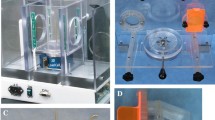Abstract
We examined the changes in learned and spontaneous motor behavior after a unilateral excitotoxin lesion of the neostriatum. Cats were trained to perform a sensory-cued GO/NO-GO reaching task. Success rate, reaction time, movement speed and kinematic patterns were used to characterize motor system properties. In addition, motor properties before and after the lesion were compared by clinical neurological examinations and video tape observations of free-range behavior. We found that in normal animals motor performance in the task was fluent, highly automatic and skillful with consistent patterns from trial to trial and day to day. The striatal lesion resulted in a marked impairment in the animals’ ability to perform the automatic response to the sensory cues in the motor task. In contrast, sensorimotor behavior in contexts apart from the task was altered minimally, with changes that were often difficult to detect. The animals recovered their ability to perform the task gradually, although they never reached prelesion performance levels in up to 24 weeks of evaluation. The animals had difficulty making reaching movements in GO trials and, in NO-GO trials failures to withhold movements were more frequent. Failures were due to a specific inability to execute previously well-learned movements in response to cues and not to an inability to recognize and interpret the cues. The lesion effects were restricted to the automatic motor response to the learned cues, as the animals could make reaching movements to the target without obvious impairment in response to novel stimuli. They also made similar spontaneous movements apart from the motor task that appeared to be unimpaired. The unique motor style and strategies that characterized the behavior of individual animals prior to the lesion were still evident after the lesion, even though they were superimposed on lower success rates and slower movement speeds. Our findings suggest that the basal ganglia facilitate the fluent and rapid execution of sequences of well-learned sensorimotor behavior, but the representations of motor plans are not stored in the basal ganglia.
Similar content being viewed by others
Author information
Authors and Affiliations
Additional information
Received: 19 December 1995 / Accepted: 29 July 1996
Rights and permissions
About this article
Cite this article
Aldridge, J., Thompson, J. & Gilman, S. Unilateral striatal lesions in the cat disrupt well-learned motor plans in a GO/NO-GO reaching task. Exp Brain Res 113, 379–393 (1997). https://doi.org/10.1007/PL00005592
Issue Date:
DOI: https://doi.org/10.1007/PL00005592




